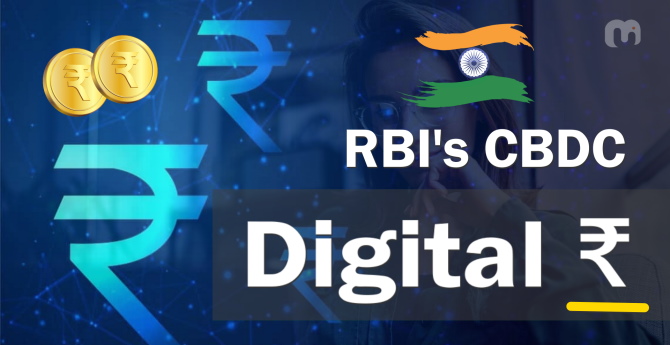
What is CBDC?
The Reserve Bank of India launched the pilot program for the central bank digital currency (CBDC) also called as the Digital Rupee of India. This is essentially the digital avatar of currency notes – “The Indian Rupee” issued by a central bank and will be a legal tender.
As the name indicates, it only exists in the electronic form and accessible only via computers and mobile phones. But at the same time, it is exchangeable one-to-one with the physical currency notes which is also called the fiat currency.
The RBI has proposed to issue two versions of Digital Rupee — A general purpose or retail version and one for wholesale. Retail CBDC can be used by all including the private sector, non-financial consumers, and businesses and the wholesale CBDC is designed for restricted access to select financial institutions.
While the retail CBDC is targeted for use in place of cash, it is primarily meant for retail transactions. On the other hand, the wholesale CBDC is designed for the settlement of interbank transfers and related wholesale transactions.
Pilot Launched…
In fact, with the first pilot for retail Digital ₹ is recently launched on Dec 1st 2022. The currency would be in the form of a digital token that represents legal tender. It is issued in the same denominations to match with the paper currency & Coins.
The digital ₹ is being distributed through banks and users will be able to transact with it thru a digital wallet offered by the 8 participating banks and gets stored on mobile phones/devices. The transactions through Digital Rupee can be both Person-to-Person and Person-to-Merchant.
How will a CBDC be different from prevalent digital systems?
A CBDC would differ from existing digital money available to the public because a CBDC would be a liability of the Reserve Bank, and not of a commercial bank / any other Institution.
There’s one thing that’s clear a CBDC transaction will be final and there will be no requirement for settlements between any banking systems.
Assume you pay using current UPI payment system for any transaction using any UPI enabled app. You know UPI stands for unified payments Interface. So, our Google pay, phone pe, BHIM all of these work on this platform. In this case the funds get transferred from your bank account to the vendors bank account. So, there are two banking systems involved here. The settlement between these banks happens periodically on a daily basis or predefined interval.
When you use digital rupee to transact, then this would be literally equivalent to a cash transaction, where money moves from your account to vendor account without any intermediary. That means no bank settlements required when a retail CBDC transaction happens.
Why does RBI push for Digital Rupee?
The most important reason for launching a digital rupee by the RBI is to push India forward in the virtual currency race. And, of course, due to the growing importance of cryptocurrency. The introduction of Digital rupee shall offer various benefits:
- With blockchain technology, the digital rupee will increase efficiency and transparency.
- Blockchain will also enable real-time tracking and ledger maintenance.
- The payment system will be available to wholesale and retail customers 24/7.
- Indian buyers can pay without a middleman.
- Lower transaction cost.
- Real-time account settlements.
- You don’t have to open a bank account to transact with a digital rupee.
- Fast cross-border transactions.
- No risk of volatility, as the RBI, will back it.
- Compared to currency notes, the digital rupee will be mobile forever.
However, with a massive payment system like UPI in place, can Digital ₹ up the game?
According to a recent survey by the RBI, cash remains the preferred mode of payment for receiving money for regular expenses. Cash is used predominantly for small value transactions (that amounts up to 500 rupees). So if the preference for cash is a reflection for preference for anonymity then those users can be redirected to accept the CBDC as long as that anonymity is assured. So that brings us to the question of anonymity.
The inference here is that such anonymity can be achieved with the help of various technologies, among them blockchain is the important one. The public will be able to use the retail version of CBDC through digital tokens. so, in a sense you can find a recipient’s public key something like a UPI id or email and then use the private key or a password to transfer money. Unlike a cash transaction where the identity of the purchaser remains completely anonymous, with digital tokens being transferred, anonymity would be partially assured. The reserve bank’s concept note has assured partial anonymity for the retail users.
Where do other countries stand?
Around 81 countries, representing over 90% of global GDP, are exploring CBDC’s. While 14 countries have tested pilots that includes China, South Korea, England, & Russia. In 16 more countries – CBDC’s are in development phase. Many more countries are in research phase. At least 7 countries including the Bahamas, Nigeria, and Eastern Caribbean Union – have reportedly launched a centrally governed digital currency.
China’s eCNY or the Chinese digital yuan is said to be available in about 23 cities in that country now. it is said to be a direct liability of the Chinese Central Bank without the involvement of any commercial banks. in other words, the digital wallets of users do not require a bank account to be held by them for them to be able to transact with using the digital currency. Of course, if a user wants to transfer his or her cash balances in bank accounts, into these mobile wallets that host these digital currencies then he or she would have to go via these designated banks.
International Transactions
How can CBDC’s help settling international transactions. The internationalization of CBDC’s will help solve payment issues that bodies like the group of 20 nations and bank of international settlements face currently. The cost of cross-border transactions is still pretty high as well as the time needed for such settlements. CBDC’s would probably be the most efficient solution for this. Let’s assume that India and the US has launched their respective CBDC’s in the near future and assuming that these two systems can talk to each other. Then transactions between these two countries do not need to wait for banks to settle. As a result, an Indian importer could pay his American supplier in real time. The transaction is final and it’s as if cash dollars are actually handed over. The system would not even require the US federal reserve to be open for such settlements. And the time zone differences would become immaterial for these type of transactions.
Does the 30% Tax on Cryptocurrencies applicable to Digital rupee?
The answer is no. RBI’s Digital rupee will be free from tax regulations to transact.
Now what is the way forward?
There is a clear need to create awareness and popularize digital currency specifically in the rural areas, where digital penetration is still a problem. Because of this difference in technology adaption levels, we definitely have to introduce a protocol for offline use, which has to be worked out. That means you can pay in the offline mode as well, where internet penetration is not very satisfactory.
Apart from that, we need to have some sort of strict KYC norms to ensure that you can track anybody if in case there is a need. This will help to ensure fair usage of the system with out any loopholes. Again all these should happen without affecting the data privacy and anonymity needs of the system to be successful. May be we don’t have answers for some of these questions at this stage.
Thanks for Reading. Stay tuned!

Look forward to connecting with you!
Finally, “subscribe” to my newsletter, so that you get notified every time when I publish.
Check out some of my videos here, and do subscribe to my channel.
– Murukesh Jayaraj
#DigitalRupee #CBDC #RBI #RetailCBDC


